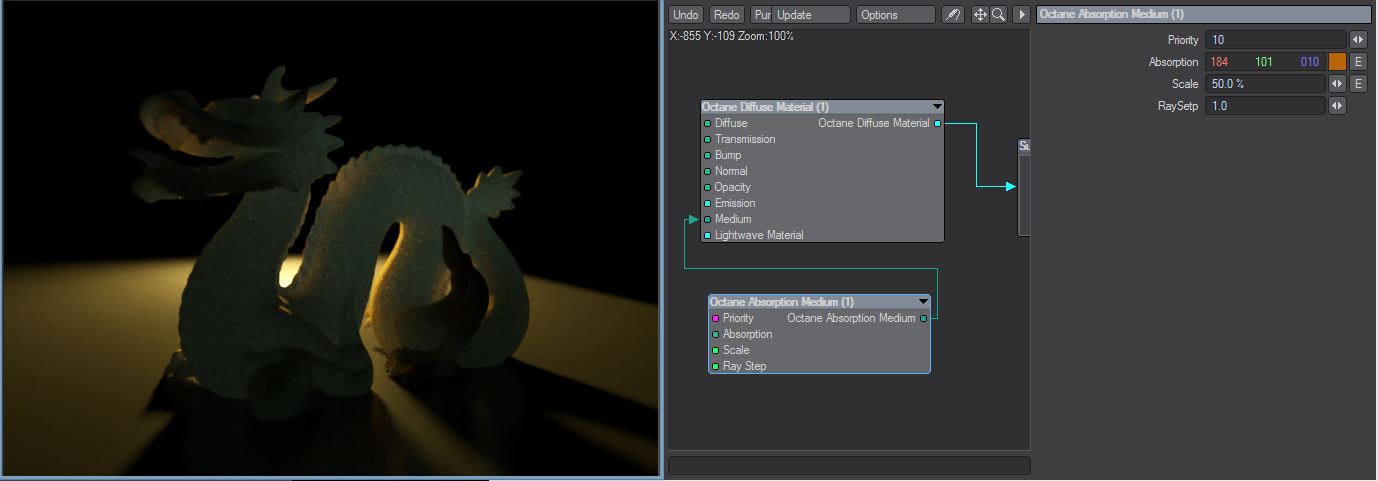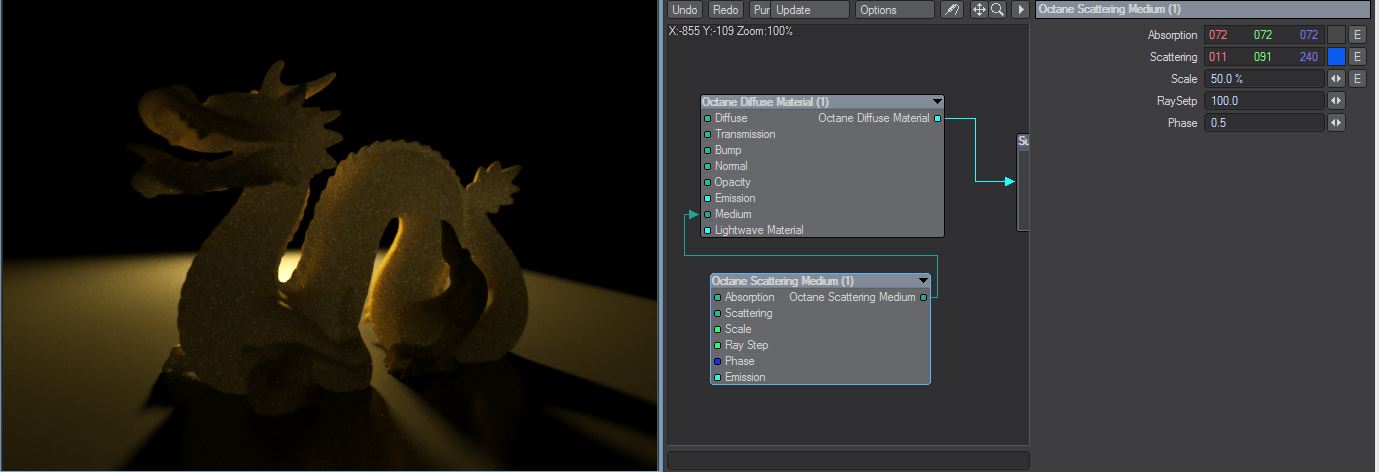
OctaneRender™ supports participating media inside objects (absorption, SubSurface ScatteringDefines how fast light gets scattered when traveling through the medium. and emission). These settings are stored in medium nodes, which are attached to the corresponding input pin of diffuse or specular material nodes.
There are two types of medium nodes, absorption and scattering. Scattering has parameters for absorption and scattering of light passing through the medium, and emission inside the medium. AbsorptionDefines how fast light is absorbed while passing through a medium. is a simple version with only absorption.
Rendering a medium requires the path tracing or PMC kernel, with a sufficiently large maxdepth setting. For media inside diffuse transmitting materials the direct light kernel with DiffuseAmount of diffusion, or the reflection of light photons at different angles from an uneven or granular surface. Used for dull, non-reflecting materials or mesh emitters. (4) GI mode can be used as well.
Participating media should only be added to meshes that define a closed volume, rather than planes. Using planes to model leaves of a plant with SSS will for instance not work. Using a single plane as ground plane should be OK (it will be treated as an infinively deep material). The mesh can have opaque objects nested inside, but nested participating media are not supported.
A specular material is the easiest: by default it is set up properly. TransmissionA surface characteristic that determines if light may pass through a surface volume. must be nonzero; for the best effect reflection and transmission should be set to 1.0.
On diffuse materials subsurface scattering only works after they are set up with diffuse transmission.
The reflection value needs to be set to a sufficiently low value, as only the part of the spectrum that is not reflected can enter the inside of the object. If the reflection is set to 1.0, all light gets reflected regardless of the transmission value. If set to 0.0, all light gets transmitted, but this gives an unnatural appearance. Values of 0.1–0.2 are a good starting point.
Also, if the reflection is coloured, the transmitted light will have the complementary color (e.g., if the reflection is set to yellow, the transmitted light is blueish).
The transmission value works the same as in the previous releases, and is multiplied with the complement of the reflection spectrum. This should be set to a high value. If possible, use a diffuse transmitting material.
Absorption Medium Node
Absorption is controlled with the absorption texture, which defines how fast light is absorbed while passing through a medium. A setting of 0.0 means no absorption. The higher the value the faster light is absorbed by the medium. This setting is wavelength-dependent, in the following setup for example it is set to absorb blue light faster than other colors, giving the object a yellow appearance.
The absorption texture is multiplied with the scale parameter. This allows setting a wide range of values more easily.

Scattering Medium Node
Subsurface scattering is controlled by the scatter texture (multiplied by the scale value), and the phase function. The scattering texture defines how fast light gets scattered when traveling through the medium, in a similar way to how absorption is defined. A very high value means light gets scattered very fast, a value of 0.0 means no scattering.
The phase function controls in what direction light gets scattered. There is currently one kind of phase function defined, with one parameter, scattering_direction. If set to 0.0, it means light gets scattered the same amount in any direction. A setting larger than 0.0 means forward scattering, the larger the value, the more light is scattered in a similar direction as it was traveling. 1.0 means it doesn’t change direction. A negative value means backscattering, so more light is scattered back to where it came from.
Scattering inside a specular material will introduce a lot of noise. It will work best with smooth illumination.
Finally emission is defined by attaching an emission node to the emission input pin. When connecting an emission node to a medium node, it defines emission inside the volume instead of at the surface of the object. The power parameter gets a different meaning: it controls how fast the radiance along a ray increases while traveling through the volume, and not the total power. It is not multiplied with the scale parameter.
This effect works best with large and not too bright objects, very small bright objects will create a lot of noise.
The stepsize parameter allows lowering the average distance between points where Octane samples the absorption, scattering and emission textures. If these textures are not constant, lowering this parameter may improve the appearance of the material, but if set too low the ray tracing may terminate before the ray is traced back out of the material.
The priority input is currently not used.
